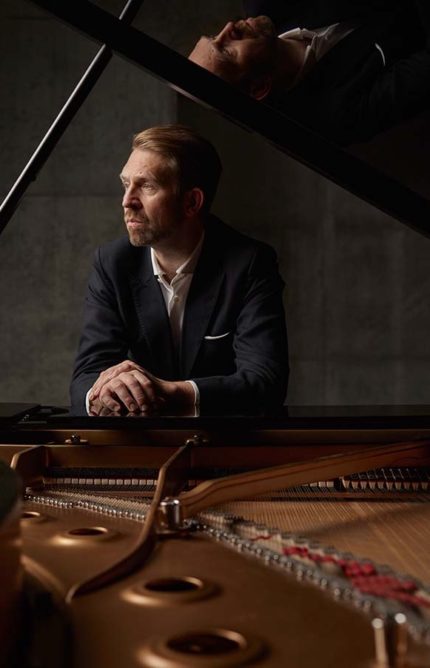Andsnes’ consummate artistry illuminates Dvořák rarity and our times

It was heartening to see the large turnout for Leif Ove Andsnes’ recital Sunday afternoon, as well as the rapt attention the Symphony Center audience members gave to the Norwegian pianist’s thoughtful program.
Andsnes is among our finest and most versatile keyboard artists. When Riccardo Muti was indisposed for a CSO concert last April, the pianist seamlessly took over orchestral direction as well as solo duties, leading two Mozart concertos from the keyboard.
Andsnes’ intelligent recital on Sunday blended a prevailing meditative element with a humanistic quality that reflected our fraught era, touching on sadly relevant themes of war and internal state oppression.
Lamento by Alexander Vustin led off the afternoon and set the dominant mood. The work was inspired by a bird singing during a funeral ceremony that the Russian composer attended. Andsnes brought out the elegiac expression of this short work, which sets angular birdsong in the right hand against a dirge-like bass motto in the left. Vustin passed away himself in 2020, a victim of the first Moscow wave of Covid-19.
Andsnes maintained the mood by fluently unfolding the four works on the first half in a continuous, unbroken flow, briefly pausing after each work before segueing into the next.
Leoš Janáček’s Sonata 1.X.1905 is the earliest work to show his individual voice. Subtitled “From the Street,” this concise, two-movement sonata pays homage to a Czech student killed by Austrian troops during nationalist university protests. Andsnes deftly balanced the wistful peace and broken-chord fury of the first movement as well as giving the somber valedictory expression of the finale strength and quiet eloquence.
It was worthy and apt to have music from Valentyn Silvestrov on the program. Ukraine’s greatest living composer, the prolific Silvestrov has written nine symphonies and a vast amount of piano music, including five books of bagatelles. One of his earliest essays in that form is the Bagatelle, Op. 1, no. 3, and Andsnes gave the simple, songlike melody its due without inflating the scale.
Silvestrov’s miniature nicely queued up Beethoven’s Sonata No. 31 in A-flat major. In Andsnes’ hands, the composer’s Op. 110, his penultimate work in the genre, seemed to encapsulate and apotheosize the essence of all the music explored in the first half.
If the first movement seemed somewhat over-tempered to better integrate Beethoven’s world with the previous works, Andsnes firmly brought out the bumptious energy and playful contrasts of the middle movement. In the finale, the pianist gave the opening chords spacious scale and the ensuing fugue a searching quality and inevitability. Bringing increasing depth and gravitas to each iteration, the performance was rounded off with emphatic power and elevated expression by Andsnes.
The second half of the program was devoted to Dvořák’s rarely heard Poetic Tone Pictures.
As popular as his symphonies and concertos are, there are vast sections of Dvořák’s oeuvre that remain almost completely unknown, including eight of his nine operas and nearly all of his solo piano music. Kudos then to Andsnes for lending his high-level advocacy to Dvořák’s Op. 85 by recording this music for Sony and performing this nearly hour-long score in its entirety as the composer preferred.
Reflecting its name, the Poetic Tone Pictures is composed of 13 individual sections with evocative titles. While Dvořák’s melodic richness is always to the fore, the titled pictures seem more suggestive than directly programmatic. Most impressive is how surely crafted and pianistic these works are for a composer who was a string player and professional violist rather than a pianist.
Andsnes managed to hold this vast work together with atmospheric playing, acutely varied expression and masterful pacing. From the charming stream-like opening of the first item, “Twilight Way,” each picture’s essence was finely painted: the dark rumination of “In the Old Castle,” the al fresco good cheer of “Spring Song,” cavorting skeletons of “Goblins’ Dance,” or the stately lyricism of “Serenade.” The bursts of virtuosity were handled with unerring polish and elan. In the concluding sections, Andsnes conveyed the noble expression of “At a Hero’s Grave” as surely as the luminous power of “On the Holy Mount.”
I’m not sure Dvořák’s Op. 85 will ever become a repertoire standard in its complete form due to its length and segmented structure. Still, Andsnes made a supreme case for rediscovery of this music, which helps to round out our portrait of the Czech composer.
Repeated ovations brought Andsnes back out for two encores.
Kjempeviseslåtten (Ballad of Revolt) by the pianist’s compatriot Harald Sæverud was written in protest against the Nazi invaders of Norway in 1943. Andsnes’s intense and sonorous performance of this spiky protest music made its contemporary relevance bitingly clear and manifest.
A firm-lined account of Chopin’s Mazurka in C-sharp Minor, Op. 30, no. 4, closed an illuminating, consummately performed afternoon of piano music.